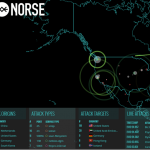
Interactive Cyber Maps
Everyday we are reading about Internet attacks, attempting to take sites offline, for a variety of reasons. For most people it is difficult to visualize this type of activity, after all it occurs on a wire, from computer to computer,…
Attack of the Week: Log Jam
Web-browser makers are preparing a fix for a flaw in an encryption algorithm that makes it possible to spy on supposedly secure communications. However, the updates will mean a minority of websites will be blocked by the new software. The…
Careful what you click…
Over 10,000 people have been hit by Cryptolocker in the last week. To refresh your memory, CryptoLocker is a Trojan that encrypts documents on victims’ computers and holds them ransom for $300. If you don’t cough up the money, CryptoLocker…
Targeted attacks, mobile vulnerabilities on the rise
The findings of the latest “Internet Security Threat Report” from Symantec can be summed up as: “Attacks are rising, but the number of new vulnerabilities is decreasing.” This describes the threat landscape in 2011 in which hackers continued to exploit…
Flame virus, what is the reality?
Is Flame, the third series of viruses to attack Iran, the creation of gamers or cyber warriors? Then again, any story with the words “Iran,” “espionage” and “attack” are bound to attract attention. I have a question. Why would a…
U.S. Says “Hack us and we might bomb you”!
The US revealed its “International Strategy for Cyberspace” (PDF) yesterday. It’s mostly blather about how terrific “cyberspace” is, but it gets more specific on a few key issues like national defense. Could our next war start because of a hack?…
‘Blackhole’ attack tool spreads across the Internet
An online attack tool known as Blackhole has stormed onto the market in the first part of 2011 and is being used for large-scale attacks, according to experts. Security vendor AVG said in its latest quarterly security report that the…
Attack Hijacks Data Via Newer Windows Features…
Attack hijacks sensitive data using newer Windows features. Security researchers have outlined a way to hijack huge amounts of confidential network traffic by exploiting default behavior in Microsoft’s Windows operating system. The man-in-the-middle attacks described April 4 take advantage of…
